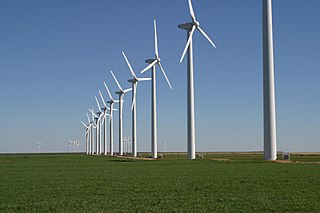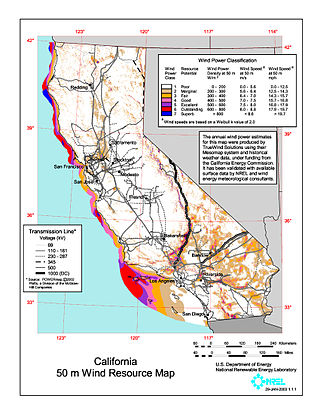
Wind power is the use of wind energy to generate useful work. Historically, wind power was used by sails, windmills and windpumps, but today it is mostly used to generate electricity. This article deals only with wind power for electricity generation. Today, wind power is generated almost completely with wind turbines, generally grouped into wind farms and connected to the electrical grid.

A wind farm or wind park, also called a wind power station or wind power plant, is a group of wind turbines in the same location used to produce electricity. Wind farms vary in size from a small number of turbines to several hundred wind turbines covering an extensive area. Wind farms can be either onshore or offshore.
Ian Fells is Emeritus Professor of Energy Conversion at the University of Newcastle upon Tyne, and former chairman of the "New and Renewable Energy Centre" at Blyth, Northumberland, England.

Adam Robert Bruce is a Scottish solicitor, businessman, and aristocrat who serves as an officer of Arms at the Court of the Lord Lyon.

Energy in the United Kingdom came mostly from fossil fuels in 2021. Total energy consumption in the United Kingdom was 142.0 million tonnes of oil equivalent in 2019. In 2014, the UK had an energy consumption per capita of 2.78 tonnes of oil equivalent compared to a world average of 1.92 tonnes of oil equivalent. Demand for electricity in 2014 was 34.42 GW on average coming from a total electricity generation of 335.0 TWh.

The United Kingdom is the best location for wind power in Europe and one of the best in the world. The combination of long coastline, shallow water and strong winds make offshore wind unusually effective.

The Centre for Renewable Energy Systems Technology (CREST) is a research centre into renewable energy based in the Department of Mechanical, Electrical and Manufacturing Engineering, Loughborough University in England.

The production of renewable energy in Scotland is a topic that came to the fore in technical, economic, and political terms during the opening years of the 21st century. The natural resource base for renewable energy is high by European, and even global standards, with the most important potential sources being wind, wave, and tide. Renewables generate almost all of Scotland's electricity, mostly from the country's wind power.

Wind power is a branch of the energy industry that has expanded quickly in the United States over the last several years. From January through December 2022, 434.8 terawatt-hours were generated by wind power, or 10.25% of electricity in the United States. The average wind turbine generates enough electricity in 46 minutes to power the average American home for one month. In 2019, wind power surpassed hydroelectric power as the largest renewable energy source in the U.S.

Wind power generation capacity in India has significantly increased in recent years. As of 31 August 2023, the total installed wind power capacity was 44.089 gigawatts (GW), the fourth largest installed wind power capacity in the world. Wind power capacity is mainly spread across the southern, western, and northwestern states.

Wind power in California had initiative and early development during Governor Jerry Brown's first two terms in the late 1970s and early 1980s. The state's wind power capacity has grown by nearly 350% since 2001, when it was less than 1,700 MW. In 2016, wind energy supplied about 6.9% of California's total electricity needs, or enough to power more than 1.3 million households. Most of California's wind generation is found in the Tehachapi area of Kern County, California, with some large projects in Solano, Contra Costa and Riverside counties as well. California is among the states with the largest amount of installed wind power capacity. In recent years, California has lagged behind other states when it comes to the installation of wind power. It was ranked 4th overall for wind power electrical generation at the end of 2016 behind Texas, Iowa, and Oklahoma. As of 2019, California had 5,973 megawatts (MW) of wind power generating capacity installed.

Renewable energy in the United Kingdom contributes to production for electricity, heat, and transport.
Eddie O'Connor is an Irish businessman who is co-founder and chairman of Mainstream Renewable Power, a renewable energy group.

Wind power in Romania has total cumulative installed capacity of 3,028 MW as of the end of 2016, up from the 14 MW installed capacity in 2009.

A floating wind turbine is an offshore wind turbine mounted on a floating structure that allows the turbine to generate electricity in water depths where fixed-foundation turbines are not feasible. Floating wind farms have the potential to significantly increase the sea area available for offshore wind farms, especially in countries with limited shallow waters, such as Spain, Portugal, Japan, France and the United States' West Coast. Locating wind farms further offshore can also reduce visual pollution, provide better accommodation for fishing and shipping lanes, and reach stronger and more consistent winds.
Peter Douglas Dunn OBE was a British engineer.

The North Seas Energy Cooperation (NSEC), officially the Political Declaration on energy cooperation between the North Seas Countries, is a collaboration between EU member-states and Norway to create an integrated offshore energy grid which links wind farms and other renewable energy sources across the northern seas of Europe. First proposed as the North Seas Countries Offshore Grid Initiative (NSCOGI), it is one of several European super grid schemes.
Durham Energy Institute (DEI) is a research institute located within Durham University, England. It was launched in September 2009 for research in the fields of energy technology and society. The current Executive Director is Professor Jon Gluyas.

James G.P. Dehlsen is an American businessman, inventor, and entrepreneur. He is a pioneering figure in wind power and renewable energy development in the United States and holds 25 patents.

Andrew Garrad is an engineer and businessman and one of the pioneers of the modern wind energy industry. In 1984 he co-founded the consulting company Garrad Hassan ("GH") which supported the industry through design consultancy, testing, measurements, energy evaluation and technical due diligence. Software and services provided by GH became widely used.















